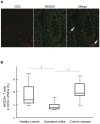Decrease of peripheral and intestinal NKG2A-positive T cells in patients with ulcerative colitis
- PMID: 22970169
- PMCID: PMC3435414
- DOI: 10.1371/journal.pone.0044113
Decrease of peripheral and intestinal NKG2A-positive T cells in patients with ulcerative colitis
Abstract
To investigate the role of inhibitory natural killer receptors (iNKRs) in inflammatory bowel disease (IBD), we analyzed the expression of NKG2A, one of the iNKRs, on T cells in a mouse colitis model and human IBD. During the active phase of dextran sulfate sodium (DSS)-induced mouse colitis, the frequency of NKG2A+ T cells was significantly decreased in the peripheral blood, and increased in the intestine, suggesting the mobilization of this T cell subset to the sites of inflammation. Administration of anti-NKG2A antibody increased the number of inflammatory foci in DSS-induced colitis, suggesting the involvement of NKG2A+ T cells in this colitis model. In ulcerative colitis (UC) patients, the frequency of peripheral blood NKG2A+ T cells was significantly decreased, compared with Crohn's disease (CD) patients and healthy controls, regardless of clinical conditions such as treatment modalities and disease activity. Notably, in sharp contrast to the DSS-induced mouse colitis model, the frequency of NKG2A+ cells among intestinal T cells was also decreased in UC patients. These results suggest that inadequate local infiltration of NKG2A+ T cells may be involved in the pathogenesis of UC.
Conflict of interest statement
Figures








References
-
- Podolsky DK (2002) Inflammatory bowel disease. N Engl J Med 347: 417–429. - PubMed
-
- Fiocchi C (1998) Inflammatory bowel disease: etiology and pathogenesis. Gastroenterology 115: 182–205. - PubMed
-
- Moretta A, Bottino C, Mingari MC, Biassoni R, Moretta L (2002) What is a natural killer cell? Nat Immunol 3: 6–8. - PubMed
-
- Ljunggren HG, Karre K (1990) In search of the ‘missing self’: MHC molecules and NK cell recognition. Immunol Today 11: 237–244. - PubMed
Publication types
MeSH terms
Substances
LinkOut - more resources
Full Text Sources
Medical

